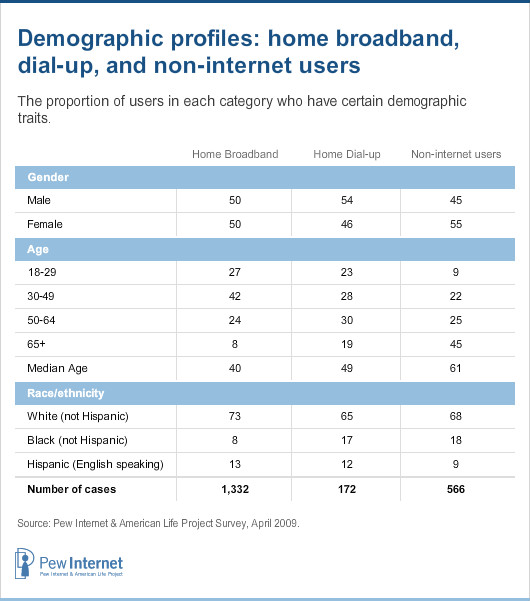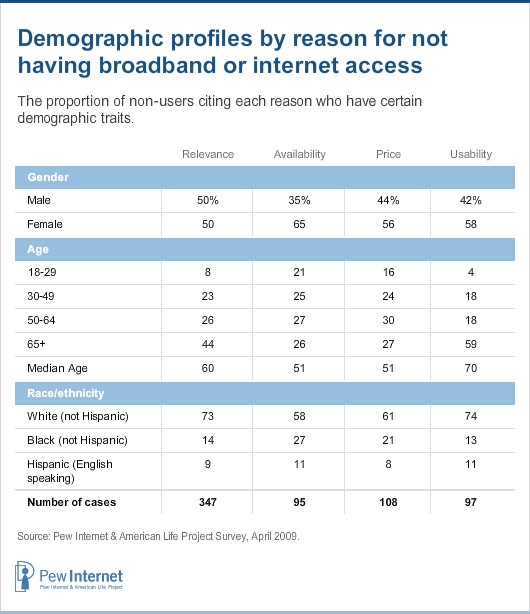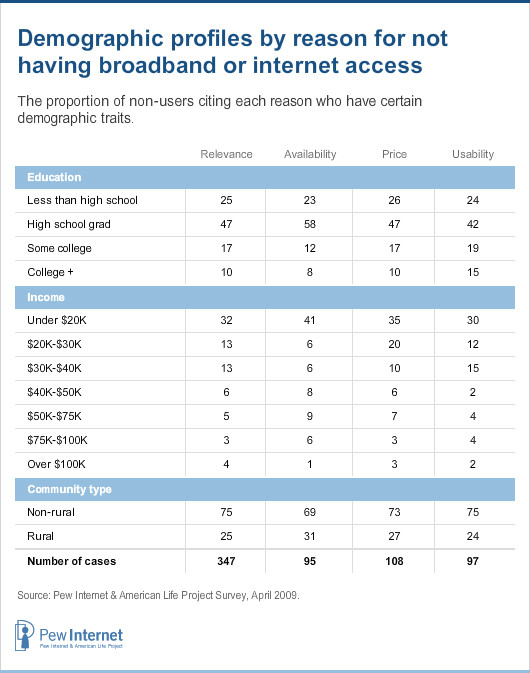Demographic differences in broadband adoption
As we did in our 2008 report on home broadband adoption, this report assesses barriers to broadband adoption through questions to dial-up users and non-internet users about why they either do not have broadband or lack internet access.
At a very broad level, there are clear demographic differences between broadband, dial-up, and non-internet users, as the following table demonstrates.


Relative to broadband users, dial-up users are older, have lower incomes, have lower levels of educational attainment, are more likely to be African American, and more likely to live in rural areas. For non-internet users, these same factors are also relevant, but in much more pronounced ways. A notable demographic difference in comparing dial-up with non-users is gender: dial-up users are more likely to be male and non-users more likely to be female.
Several of the factors common to non-broadband use are related. Those with lower levels of education have, on average, lower incomes, as do rural Americans, senior citizens, and African Americans. Two questions that arise are whether these different effects are independent of one another and, if they are, which ones are more strongly related to broadband adoption.
It turns out that a number of demographic or socio-economic factors are positively correlated with home broadband adoption, while others are negatively correlated, and that these relationships are independent of one another. The following shows those factors that are positively and negatively correlated with home broadband adoption.9They are listed in order of magnitude, that is, having a high income is a stronger predictor of having broadband than being a parent and not having graduated from high school is more strongly associated with not having broadband than living in rural America.

These relationships help reveal patterns in broadband adoption, but they are not ironclad determinants of whether a person has broadband or not. They do, however, indicate what elements are more (or less) important, at the level of demographic and socio-economic analysis, in thinking about broadband adoption. The report turns now to how attitudes about the internet also shape the broadband subscription decision.
How many dial-up users want broadband?
When asked whether they would like to switch to a faster home broadband connection at home, more dial-up users say they are not interested than those who say they do.

Since this question was first asked in 2002, about 40% of dial-up users have said they would like to switch and the number has not changed much as dial-up use has fallen to a fraction of its 2002 levels. With the pool of dial-up users diminishing, this steady figure over time means that some dial-up users are changing their preferences. That is, assuming that over time most dial-up users who switched to broadband were people who at one point said they were interested in switching, many remaining dial-up users who said they didn’t want to switch a few years ago now say they do.
Due to the small number of cases for dial-up users, reporting specifics about what subgroups of dial-up users say when asked whether they would like to switch to broadband is not appropriate. However, multivariate analysis shows that two groups are most likely to say that they would like to switch from dial-up to broadband: parents with minor children and rural dial-up users.10
What would it take to get dial-up users to switch?
When explicitly asked what would move them from the dial-up to broadband column, dial-up users haven’t changed much in their perspectives on this question since 2008. Although a plurality cite price as the reason, some two-thirds of dial-up users cite a range of other things that would have to change to get them to switch. Some reasons cited are fairly precise, such as availability of service, while others are vague, such as simply not wanting to switch or not being able to identify something specific.

What keeps non-internet users offline?
Some one-fifth of adults (21%) do not use the internet, and the April 2009 survey asked these people a series of questions about why they don’t use the internet, whether they might have people close to them who use it, and whether they have been an online user in the past.

The only statistically significant difference in 2009 in comparison with 2007 is in the share of non-internet users saying they are not interested in getting online, with non-users in 2009 a third less likely than in 2007 to say they are not interested in getting online.
For both non-internet and dial-up users, there are small increases in those saying they can’t get service where they live. For dial-up users, 17% say they cannot obtain service where they live, an increase from 14% in 2008 that is not statistically significant. For non-users, 16% cited “can’t get access” in 2009, an uptick from 12% in 2007 that is significant at the 90% confidence level. Overall, this translates into 17% of non-internet or dial-up users who cite lack of availability as a reason they do without either internet service or broadband.
As was done in January’s Pew Internet commentary, the following consolidates the findings for dial-up and non-internet users into a single table.11

The April 2009 data show that half of dial-up and non-users cite some reason relating to the relevance of the internet, about the same share that was reported earlier this year based on 2007 data.
The demographic profiles of members of each of these four groups are shown below. Those citing availability and price as barriers are somewhat younger and poorer than those citing other reasons, and more likely to be female as well.


Some “not online” Americans weren’t always that way and some live with online users
As the Pew Internet Project first documented in a 2003 report, the internet population is often in some state of flux, with some people losing access and counting themselves as non-users, as others come online to expand the overall online population.12 In our April 2009 survey, some 21% of non-internet users said they had once been users of the internet or email, but had stopped using the internet for some reason.
As to whether they would like to get back online, only 11% of non-internet users would like to start using the internet – either for first time or once again after they have lost access.
Some non-users, however, have internet users in their household. Among the 21% of non-internet users, 13% say that someone in their home uses the internet. About half (46%) of this group identify a spouse or partner as the online user in the home, while just over one-third (38%) point to a child.
As noted earlier in the report, 72% of adults have internet access at home, with another 7% having online access from elsewhere, mostly work only (4%) or some other place that is neither home nor work (3%). When non-users with an internet user in the household added to the mix, 75% of Americans live in a home with internet access.


